Grace Neary
University: Bangor University
Studying/Course: German with French
Languages: English, German, French
21 year old German with French student at Bangor University. Studying at l'Université de Bretagne Occidentale and Universität Bayreuth.
Blogs:
Self and Relationships
l’Université de Bretagne Occidentale, Brest.
L’environnement
l’Université de Bretagne Occidentale, Brest.
Travel and Transport
l’Université de Bretagne Occidentale, Brest.
Understanding the German-speaking World
Universität Bayreuth.
Feste und Feiern
Universität Bayreuth.
Self and Relationships
Bonjour, tout le monde ! Aujourd’hui je vais discuter le thème “self and relationships” ou « soi et relations » en français. Pour moi, il y a beaucoup de choses à dire sur ce thème mais j’essaierais d’être bref ! (Promise!)
Firstly, I want to talk about relationships – in all their forms. I’m going to start slightly off-the-wall and begin with my relationship with France itself. I know, I know. Bear with me! My relationship with France was a little bit like the relationship you have with kids at school you sort-of know and say hi to in the corridor when you pass but don’t hang out with at break and lunch times. You know, I’d been on holiday there a couple of times and I’d passed through on my way to other parts of Europe but I didn’t really know France. Comment les temps on changé ! (For me, at least.)
So… When I rocked up in Brest, Bretagne (in the North-West of France), I had no idea what to expect and I learnt so, so much. J’apprenais le mode de vie français – les attitudes des Français, leur étiquette, leur fierté nationale et locale, leur cuisine et j’ai découvert une ville entière ainsi que toute son histoire et sa culture. J’étais choquée ! Brest n’était pas du tout comme Paris ou le village typiquement provençal. Brest was entirely its own place; ruined by the Second World War and hastily built back up with concrete structures, shaped by its coastal location and maritime trade, full of Breton pride and dedication to the local area, people and culture, Brest was a place I had no idea would be the way it was. It has shaped my relationship with France irrevocably – I can never think of France without remembering the lecture halls of l’Université de Bretagne Occidentale and the French students on all sides or accidentally ordering a lettuce sandwich in Subway and being laughed at or the bartender at the local pub we made friends with who played in the local football team and called everyone in Brest his friend. Il y aura toujours un lien entre moi et la France et ma relation est maintenant meilleure – parce que je comprends un mode de vie que je ne connaissais même pas avant !
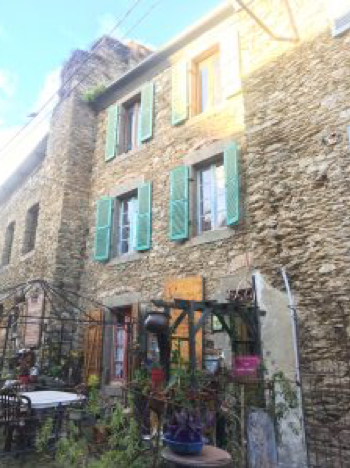

One of the buildings on the oldest street in Brest: one of the only remaining with pre-war structures. Some of the grey, post-war, concrete architecture! Not too bad when the light hit it right – and the sea is always beautiful!
Secondly, relationship-wise, I want to discuss a more typical understanding of the word. It’s a scary time, in the beginning, leaving your country and all your friends and just hoping you’ll be able to make some more when you’re abroad. Heureusement, je me suis fait d’excellents amis. La chose amusante est que l’un d’eux est venu de mon université, mais nous ne nous connaissions pas vraiment auparavant. Nous étions tous des étudiants Erasmus et nous nous entraidions lorsqu’il était difficile de trouver des salles de classe ou des examens, de traduire des choses difficiles, et nous cuisinions et faisions nos courses ensemble. Mon activité préférée était de traîner dans la cuisine et de boire du thé que ma maman avait envoyé du Royaume-Uni. Cela m’a vraiment aidé avec mon « hiraeth ». I missed my friends from home, of course, and was so excited when December came and I could visit them and I missed my family and boyfriend something rotten – but it was so important for me to have friends who all felt similarly and we all made sure that we made the most of our experience abroad. We were a little support system armed with tea! One of my fondest memories is the trip we took to Paris – hunting down the only vegan croissants I’d had in my whole four months abroad and seeing things like the (not-so) tiny Statue of Liberty, the art gallery in the Centre Georges-Pompidou and, perhaps most poignantly, the Holocaust memorial. We went in every cathedral we saw (never seen so much stained glass), visited a famous English language bookshop (whoops! I know, not the cultural experience I was supposed to have but Shakespeare & Company was amazing) stocked floor-to-ceiling with books (!!) and seeing the Eiffel Tower from absolutely every angle possible.
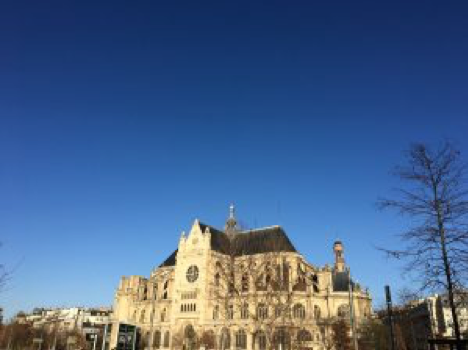
An excellent example of a Parisian cathedral – Saint Eustache!

Not really a trip to Paris without a shot of the Eiffel Tower. Yes, a little foggy and when I said from “all angles” I didn’t mean quite from this one… but technology isn’t my friend and you get the gist!
And these friends and all these experiences also shaped a different relationship: the one I have with myself. Je suis plus sûre de moi, plus forte, plus disposée à faire de nouvelles choses et je suis plus heureuse parce que je sais que je suis capable de faire ce que je veux. The monde is most definitely my huître! Je vais bientôt aller seul en Espagne, ce qui ne fait plus peur, je vis depuis quatre mois déjà dans un pays étranger et tout ce qui me fait peur n’est rien en comparaison ! Le semestre à l’étranger n’était pas parfait – pas de loin – mais cela a changé ma relation et ma façon de voir le monde et je suis tellement heureuse de l’avoir fait. I met such lovely, funny people and did so many things I could never have imagined me doing (like actually understanding lectures in French about how the way the brain works and how that affects the way people pick up and then speak languages) and I’m now ready for anything the universe could possibly throw at me. It’s a world away from sitting in my GCSE and A-Level classes and wondering how on Earth I was ever going to speak French well enough to pass my exams – never mind go to France and speak to actual real-life French people! I can do that now (90% of the time because, hey, I’m still not fluent… but another thing I learnt about myself in France is that I can be proud of all of my achievements whether they seem big or small) which is très bien, non ?
À bientôt !
Grace x
L’environnement
Bonjour à tous! Ce mois-ci, je parle de l’environnement ! Pour moi, c’est un sujet très intéressant, surtout en ce qui concerne l’actualité. Réchauffement de la planète, plastiques dans les océans et un rapport du GIEC (en anglais c’est IPCC ou Intergovernmental Panel on Climate Change) selon lequel, dans 12 ans, le changement climatique sera irréversible – c’est choquant !
In France, I found that there was a strong awareness of climate change and the ways in which we can all help tackle the problems facing the environment. In Carrefour, my local supermarché, there were lots of advertisements about some of their environmentally friendly policies – they limited the use of pesticides in their products, for example, because of the danger they pose to both the environment and human health.
Les supermarchés contribuent également à la protection de l’environnement grâce à une politique adoptée par le gouvernement français. Les supermarchés français ne sont pas autorisés à jeter les déchets alimentaires et doivent en faire don. Ces produits alimentaires, qui auraient été mis en décharge et ont contribué au réchauffement de la planète (parce que les déchets alimentaires dans les décharges ne se décomposent pas bien), sont donnés aux banques alimentaires, etc.
This is a very cool law, as far as I’m concerned, and demonstrates the French government’s dedication to fighting climate change. In cities like Paris, the government helps decrease noise and air pollution by taxing people who drive there heavily. In fact, many zones in the city centre are car-free (one Sunday a month almost no cars are allowed to drive in much of the city and old cars are no longer allowed at all). This is supposed to incentivise people to use public transport and decongests the streets as well as the air we breathe (although it is controversial – as many are concerned the law targets those who cannot afford a newer car).
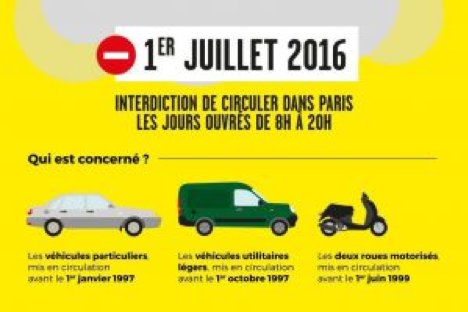
Information on the types of car banned from driving in Paris (source: Maire de Paris)
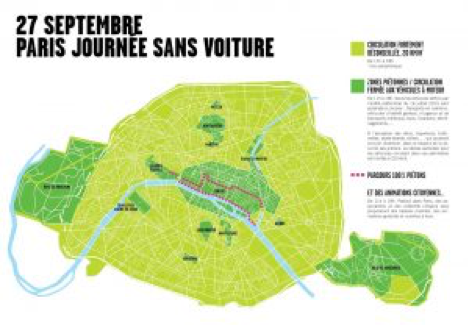
Information on the “day without cars” introduced in Paris (source: Paris sans Voiture)
Le recyclage est également très facile en France. Dans mon logement étudiant, il y avait beaucoup d’installations de recyclage. Vous pouvez recycler le plastique, le verre, le papier, le carton et même les vieux vêtements. Le logement avait aussi des poubelles à compost. On pourrait demander à utiliser le tas de compost et on pourrait y mettre leurs déchets alimentaires. Selon certains rapports, la Bretagne (où se trouve Brest) est la meilleure en France en matière de recyclage ! I was in good company for trekking all my glass bottles down to the bank then, it seems.
Again, I’m going to go off on a wee tangent (trying not to bore you and also find a reason to include some more pictures!) and talk more broadly about the environment while I’m here… Why not, eh? The local environment was that of maritime city and, by that, I mean it was a harbour. I could see the sea from the city centre and there was a beach not too far from the university. One quick bus journey away and (not so much) sun, (lots of) sea and (a bit of) sand were at my fingertips. This environment really influenced the environment of people around me. One night, when I was out with friends, I met a literal boatload of men who’d come on a submarine (no, really) and learnt all about their jobs as engineers aboard.
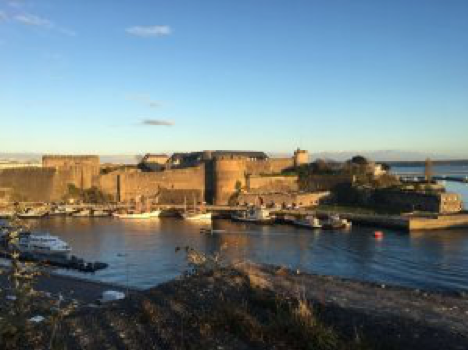
The old harbour fortifications and castle on the edge of the city
I also spent some time, when I wasn’t in class or studying, at the local botanic garden. I love a botanic garden – which is really nerdy, I know, but I do – and really appreciated being able to visit one so easily. The French name for the garden is « Jardin du Conservatoire botanique national de Brest ». Dans le jardin, il y avait des serres remplies de plantes du monde entier. Le jardin contribue à la culture et à la préservation de plantes très rares que la déforestation et les changements climatiques détruisent dans leur habitat naturel. Le jardin avait aussi quelques lacs et beaucoup d’arbres, d’oiseaux et même une hutte de Papouasie Nouvelle Guinée – construite pour montrer comment vivait le peuple autochtone de Papouasie Nouvelle Guinée. It was beautiful to see and I really liked being able to explore how the differing environments and cultures of France and Papua New Guinea affect things like the living quarters of the people there.
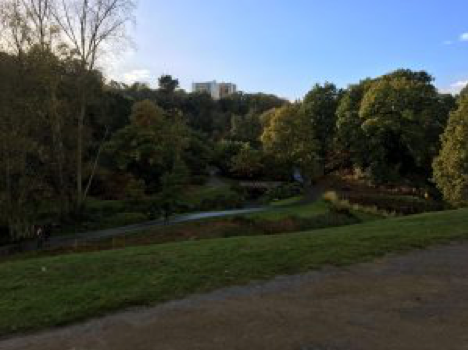
The view across the botanic garden on a rather rainy (but bright) day
Thanks for reading and I hope you liked my pictures! Remember to include some environment saving actions in your own life – it’s super easy to remember to recycle or maybe try and use less plastic if you don’t need it!
À bientôt,
Grace x
Travel and Transport
Bonjour à tous ! Aujourd’hui je vais discuter le thème « voyages et transport » ou “travel and transport”.
Quand j’étais à Brest, j’ai beaucoup utilisé les transports en commun. Les bus étaient fréquents, peu coûteux et faciles à utiliser. The French public transport is generally nationalised – which means that the government owns and operates it – unlike in Britain where most transport systems are privately owned and run for profit. This means that the public transport in France can be quite different to at home!
Par exemple, les tarifs du train sont beaucoup moins chers en France. La SNCF (l’opérateur ferroviaire) est responsable de tous les services de transport de passagers en France et les trains en France peuvent aller beaucoup plus vite que chez eux. Les rails sont également beaucoup plus larges qu’en Grande-Bretagne, ce qui signifie que les trains sont plus larges. I travelled to Morlaix on the TGV and also the TER (two types of train: train à grande vitesse et train express régional) and they can run at speeds of up to 200mph (which is 75 mph faster than most trains in Britain can).

A TER (local) service in Bretagne (source: Charles Crié)
Morlaix is the home of a large viaduct, which the trains run over, and also to rather a sad story I was very lucky to be able to read about during my visit. During the Second World War, British fighter pilots attempted to bomb and destroy the viaduct as it was part of an important transport network for the Nazis. In Morlaix, there’s a beautiful but tiny church – Notre-Dame-des-Anges. This church was built to commemorate the lives of many civilians (39 of whom were nursery-age children) who died when one of these pilots missed the viaduct and instead hit a school. The church is quite hidden and doesn’t get many visitors – but it was a lovely example of Breton architecture and when I visited, on la Toussaint (All Saints Day: a bank holiday across lots of Western Europe), it had been filled with flowers to remember those children.
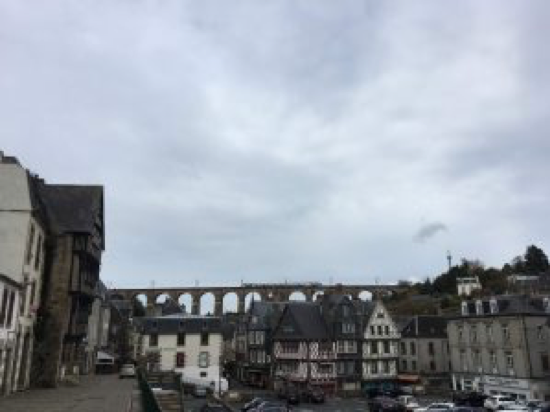
A view across Morlaix and its viaduct
Notre-Dame-des-Anges
Pendant mes études, j’ai également assisté à plusieurs événements organisés par l’université, dont un voyage en bateau. Le temps était très breton (pluie et froid) mais la vue sur la côte était magnifique ! Nous pouvions voir tous les bateaux à voile dans le port et toutes les maisons près de la plage.
Le tram était tout aussi cool. Je suis allée à la périphérie de la ville en utilisant le tram – y compris IKEA, quand j’avais besoin de trucs comme une armoire (joking, I went for a tea strainer of all things). Je n’avais jamais utilisé de tram avant, mais comme j’avais une carte pour tous les transports en Bretagne, c’était très facile à utiliser.
The best (and scariest) form of transport in Brest, however, was definitely « le téléphérique »: a cable car across the river which split the city in two! You could see across the whole city and it connected a very cool public resource centre (Les Ateliers des Capucins) – which had a library, study spaces, rooms for concerts and shows and space to skate indoors – to the centre of the city. I was a wee bit anxious every time I used it (because I’m afraid of heights) but it was worth it for all those aforementioned benefits!
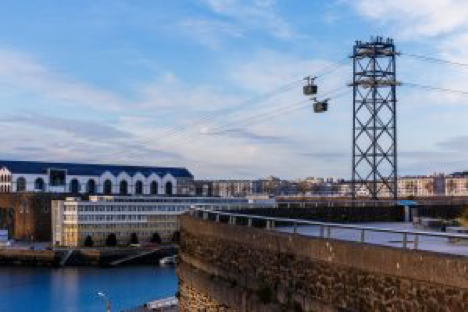
Le téléphérique de Brest ! (source: Wikipedia)
Ce sera mon dernier blog en français pour « Routes into Languages Cymru » ! C’est parce que je vais en Allemagne le mois prochain pour y étudier. Je vais aller en Allemagne en avion (contrairement à mon voyage en France – j’ai voyagé en train). Je suis ravi d’explorer l’Allemagne. Je vais en Bavière et j’espère visiter des pays comme la République tchèque, la Pologne et l’Autriche quand j’ai du temps libre. Le programme Erasmus est extrêmement spécial à cet égard. L’importance d’avoir la capacité d’étudier les langues, d’étudier à l’étranger et de voyager tout en faisant ces deux choses, c’est incroyable. Ce n’est pas facile de quitter le nid (fly the nest, en anglais), c’est sûr, mais c’est une opportunité unique. Si vous envisagez d’étudier d’autres langues (ou même si vous ne l’envisagez pas, le programme Erasmus est ouvert à tous les types d’étudiants), je le recommande vivement.
I hope you’ve enjoyed reading about some of my experiences as they relate to some of your topics in school – and even if you haven’t (!!), I hope they’ve given you some food for thought. Bonne chance with the rest of your studies and au revoir !
Grace x
Understanding the German-speaking World
Servus aus Bayern! Ich heiße Grace und ich studiere Deutsch und Französisch (Bangor Universität) und ich bin jetzt an der Universität Bayreuth. Heute spreche ich über “Understanding the German-speaking World”.
The German-speaking world, or Germanophone world, is one which has lots of different faces. The culture and language of Germanophone communities varies widely between each – the German spoken in Franken, where I am, and that spoken in Austria or Switzerland or Northern Germany or in the former German colonies of Africa can be hugely different in several aspects. Zum Beispiel sage ich „Servus“ hier in Bayreuth aber in Nord-Deutschland kann man „Moin“ sagen – beide bedeuten „Guten Tag“. Hier sagt man auch „zwo“ anstatt „zwei“ oder „gucken“ anstatt „kucken“ oder (und dieses ist mein Lieblingsbespiel) „a bisserl“ anstatt „ein bisschen“. Komisch, oder?
It’s these differences which can make it hard to understand German-speaking culture! I went on a tour of Mödlareuth (auch bekannt als „Little Berlin“, weil es im Kalten Krieg geteilt wurde) a little while ago and came away with a new understanding of Franconian culture – our tour guide was a very proud Franconian and wanted us all to know that he didn’t like Bavaria, he wasn’t Bavarian and he especially didn’t like Bayern München! It was funny (reminded me of the North vs South divide situation in England) but it gave an insight into the not-so-serious but important differences that must be considered when Keeping Up with the Germans… Maybe I should have actually said “Servus aus Franken” earlier!

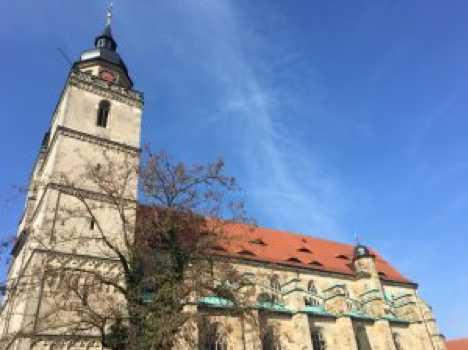
Religion can also be very important in culture – there’s lots of churches here!
Das Verständnis der deutschsprachigen Kultur hat auch für ein Studium an einer Universität in Deutschland eine große Bedeutung. Es ist sehr, sehr ander als an der Universität in Großbritannien. Von den Studierenden wird erwartet, dass sie ihre eigenen Stunden – und Prüfungspläne erstellen, und dies ist sehr unabhängig. Es gibt viele Dokumentationen und viele Dinge zu organisieren. Understanding German-speaking culture isn’t just about language – it’s about mindset as well. You’ve got to really try to become a German (at least for the little or long while you spend there) and be pünktlich, direkt und sehr klar. It’s much more appreciated that you’re clear and concise when communicating rather than polite to the point of confusion!
For lots of Germans, it’s also true that German-ness is very linked to European-ness. “Europa ist unsere Heimat” is something I’ve seen repeated a lot recently (die Europawahl war sehr wichtig hier!). Understanding why is key to understanding the culture. Obviously, historically, Germany has been a divided nation – the Holocaust, the Cold War and, further back, das Heilige Römische Reich Deutscher Nation – lots of eras of German history have been characterised by what can be seen as a “conglomeration through separation”. In 1939, the country followed an imperialistic foreign policy yet divided its own citizens by religion and race. In 1961, the Soviet Union extended its borders but cracked the satellite state it had absorbed down its centre. In the 1700s, das Heilige Römische Reich had an emperor but had no political unity or centralisation. Für viele Deutsche sind grenzüberschreitende Verbindungen sehr wichtig. Es ist eine gemeinsame Überzeugung, dass man eher Verbindungen als Mauern aufbauen sollte. Als Erasmus-Studentin spüre ich dieses Gefühl stark. Ja, zwischen Bayern und Franken gibt es Spannungen. Es gibt noch mehr zwischen Bayern und dem Rest Deutschlands! Dieses Gefühl wird jedoch durch das gemeinsame Gefühl der deutschen Muttersprachler in den Schatten gestellt. Die deutsche Kultur ist für mich eine Kultur der Freundschaft. Es gibt nichts Deutscheres als zusammen zu kommen, um eine gemeinsame Erfahrung zu machen. Sie teilen Bier auf Bierfestivals, Fußball bei Fußballspielen und Essen … die ganze Zeit. Viel zu essen.
In Bayreuth, German-speaking culture is also something to be experienced! Das Markgräfliche Opernhaus (a UNESCO world heritage site!), die alten und neuen Schlösser, die Eremitage und das Festspielhaus are all wonderful examples of historic German culture. Almost all (except the last) built under the orders of Margravine Wilhemine von Preußen (who, by the way, built most of the Baroque buildings of Bayreuth basically because she didn’t like the city and was rich enough to decide she wanted to make it a miniature Versailles and, in doing so, invented a whole new style of architecture known as “Bayreuth Rococo”) they’re all huge, beautiful, imposing buildings which have bags of history and even more windows!
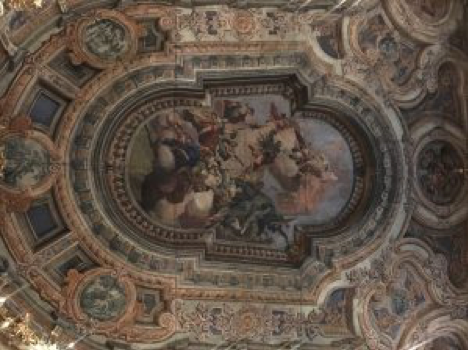
The ceiling of das Opernhaus.
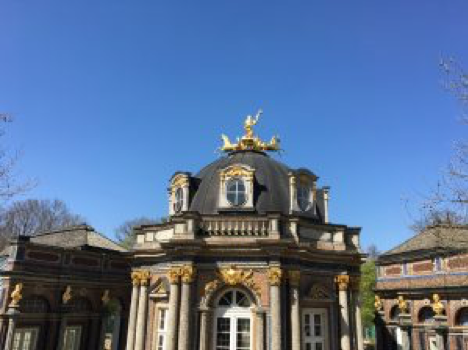
The Sonnentempel at the Eremitage.
Das Alte Schloss in the centre of Bayreuth on a slightly cloudy day
Wie man auf den Bildern sehen kann, sind sie atemberaubend. Das Opernhaus wurde als Geschenk an Wilhemines Tochter an ihrem Hochzeitstag gebaut. Es wurde einige Jahre als Theater genutzt, aber nach dem Tod von Wilhemine nicht mehr genutzt. Viele Jahre später baute Richard Wagner (der Komponist) sein Festspielhaus in Bayreuth, nachdem er vom Opernhaus und seiner eindrucksvollen Bühne in die Stadt gelockt worden war. Wagners Verbindung mit Bayreuth zog später Hitler an.
It is said that Hitler espoused Bayreuth as a “perfect German city” and it was on his orders that, on the eve of Kristallnacht, the synagogue in Bayreuth was not destroyed – it was too close to the Opernhaus and its destruction could have negatively impacted the building. For that reason, the synagogue is now the oldest still-used baroque synagogue in Germany. Wagner’s famous antisemitism and his supporters (der sogennante Bayreuther Kreis) built up a close-following of Hitler in the city and all those beautiful buildings were used as examples of a superiority of the “Aryan race” in the arts and architecture. Bayreuth became a real stronghold of National Socialism during the war.
In this, I’m trying to highlight not only what you’ve got to understand in German-speaking culture – but in all cultures. They’re multi-faceted and good and bad and everything in-between! When travelling to Germany, or further afield, it’s so important to remember that everything has at least two sides. You can never understand anything if you only ever take it at face-value.
Ich hoffe, dass ihr hattet allen Spaß, über Deutschland und meine bisherige Zeit hier zu lesen. Ach so… Auf Wiedersprechen! Viel Glück beim Lernen – Grace
Feste und Feiern
Hallo zusammen! Heute spreche ich von Festen und Feiern in Deutschland. Seit ich hier bin, habe ich mehrere Feste in Franken erlebt und einige sind speziell für diese Region!
Zuerst erwähne ich „Osterbrunnen“. Osterbrunnen ist ein besonderes Fest in der Fränkischen Schweiz und findet jedes Jahr in Bayreuth statt. All the fountains and wells across the region are decorated to celebrate the coming of Easter – it now happens across Germany but began in Oberfranken (Upper Franconia). Some of the wells have become real tourist attractions because they are so beautifully done up but even the less ostentatious versions are very pretty and really liven up city centres. They are decorated with eggs, special ribbons called “Pensala” and evergreen foliage which is formed into the shape of a crown!

The Osterbrunnen in front of Schloss Fantaisie, Bayreuth
Ich fand es wirklich interessant zu sehen und war ein hervorragendes Beispiel für die bayerische Kultur bei Festivals! Ein weiteres Beispiel für ein bayerisches Fest ist der Maibaum. Am 1. Mai wird der Maibaum jeder Stadt errichtet. Es hat die Symbole aller Handwerksvereinen und manchmal Bänder und Kränze. Zu diesem Anlass wird spezielles Maibockbier gebraut. Der Maibaum kann auch Gegenstand eines Spiels zwischen Städten werden. Traditionally, towns try to steal the maypole from their neighbours – and demand a ransom if they succeed! It’s a very important tradition for some and it’s said that, one year, a town stole another’s maypole by using a helicopter and flying away with it!
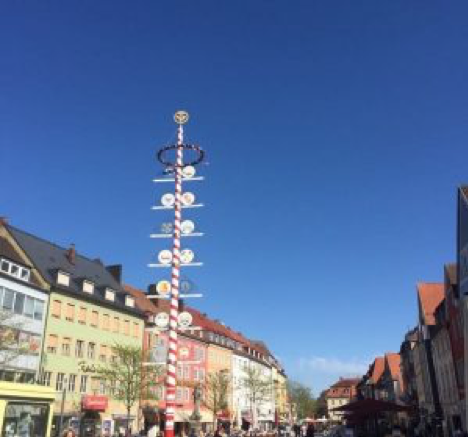
Bayreuth’s Maibaum in the city centre
Another exciting festival is the “Drachenstich Festspiele” or “Slaying of the Dragon” in Furth im Wald – the oldest traditional folk spectacle in Germany. It’s held in August and the main event is the re-enactment of the story of the slaying of a dragon who threatened the city – it’s been going on for 500 years and the city itself is known as “Drachenstadt”!
Diese Art von sogenanntem „Volksfest“ ist wirklich keine Seltenheit. Ein weiteres Volksfest in Bayern ist „Kinderzeche“. Es wird jedes Jahr in Dinkelsbühl gefeiert. Es ist eine Erinnerung an die Zeit, als die Stadt im 30-jährigen Krieg vor der Zerstörung verschont blieb. Männer und Frauen tragen traditionelle deutsche Outfits (Lederhosen und Dirndl) und haben Prozessionen, trinken Bier und geben Kindern Süßigkeiten.
Of course, Germans also celebrate many of the same things we do – although they have different names and different customs! New Year (Neujahr) and New Year’s Eve (Silvester) also have fireworks and a countdown but, in addition, every year there is a broadcast of the show “Dinner for One” on the television. It’s a British show in origin (but is virtually unknown at home – have you ever heard of it?) but has been shown in Germany for New Year every year since 1972. How funny!
In diesem Jahr wurde der internationale Frauentag zu einem Bankfeiertag im Land Berlin. Es gab Demonstrationen auf der Straße und ein feministisches Filmfestival. Der internationale Frauentag ist in Großbritannien kein offizieller Feiertag, sondern eine anerkannte Feier.
At my university, “Pfingsten” (Whit Sunday) means we have Monday and Tuesday off. The Monday is an official “Feiertag” but the story goes that so many students were absent for the following Tuesday that Bayreuth University declared it another day off! (Not sure how true that is but it’s a tradition I’m not about to argue with!)
Also … das war’s für mich! Mein Erasmus-Jahr neigt sich dem Ende zu, ebenso wie meine Blog-Einträge. Ich habe gerade meine Prüfungen und werde dann (hauptsächlich in Bayern) reisen, bevor ich nach Hause muss.
Hope you’ve found some of my entries to this blog interesting and good luck with any exams or tests that you have – and have a great summer! Tchüss – Grace